Colorful butterflies are found all around the world. Black and white butterflies are also common across multiple species.
This contrasting color combination is seen in North American, European, Asian, and African butterflies.
Most yellow and black butterflies also show secondary color marks such as white marks.
Some butterflies might even change colors to black and yellow depending on the season. African capers are among the species influenced by seasonality when it comes to the shade of yellow its females exhibit.
Some of the largest black and yellow butterflies are those in the Swallowtail family. However, black and yellow butterflies have varying wingspans, mostly between 1 and 5 inches.
Table of Contents
1. Swallowtail Butterflies
Swallowtails are a group of hundreds of colorful tropical butterflies. These butterflies can sometimes be large but they’re also known to be highly colorful.
Different types of black and yellow butterflies have contrasting coloring.
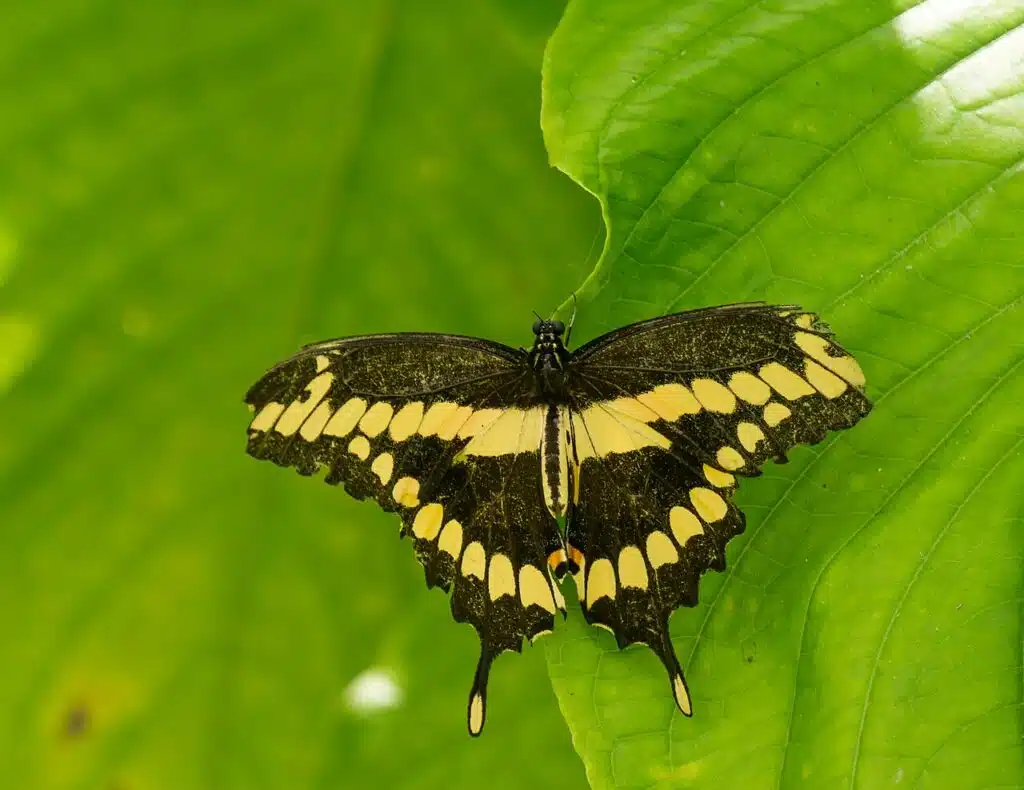
Giant Swallowtail (Papilio cresphontes) butterflies are known for being mostly black. They have 2 rows of vivid yellow marks across the wings. Tiny orange-red spots are further distinguished on their wings.
Cairns birdwing (Ornithoptera euphorion) butterflies are also mostly black and yellow. Black is the main color of the wings while yellow is intermixed with green spots for decoration. The body is yellow.
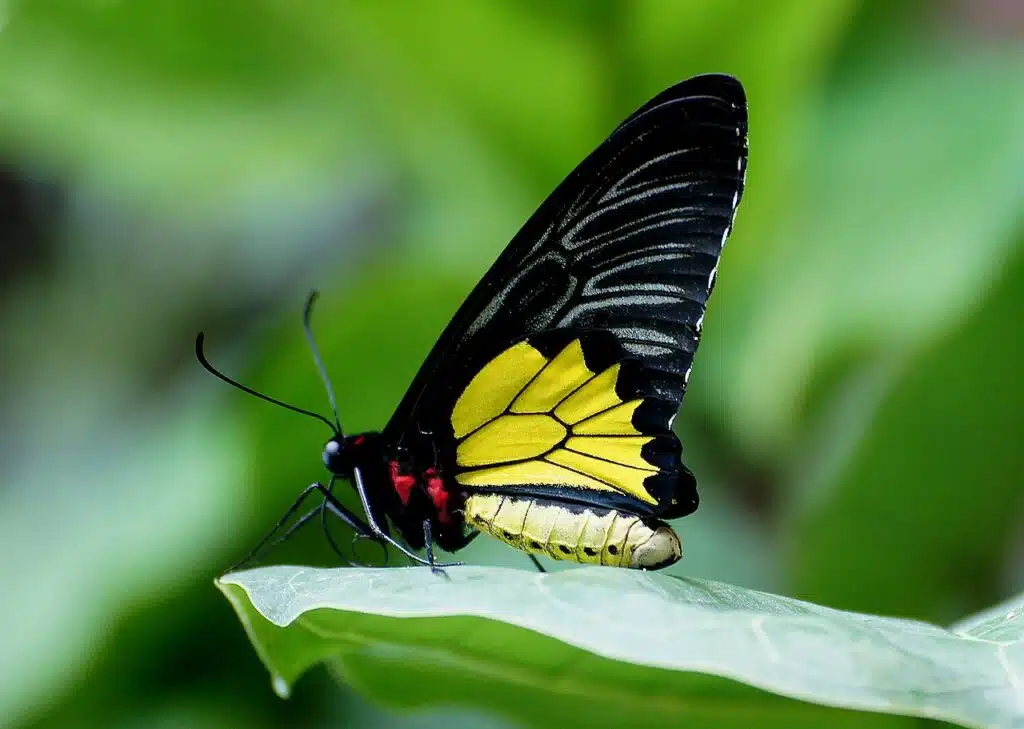
Southern festoon (Zerynthia polyxena) is another black and yellow swallowtail. This species has almost equal coverage of yellow and black across its wings. Tiny red marks are visible on its lower hindwings.
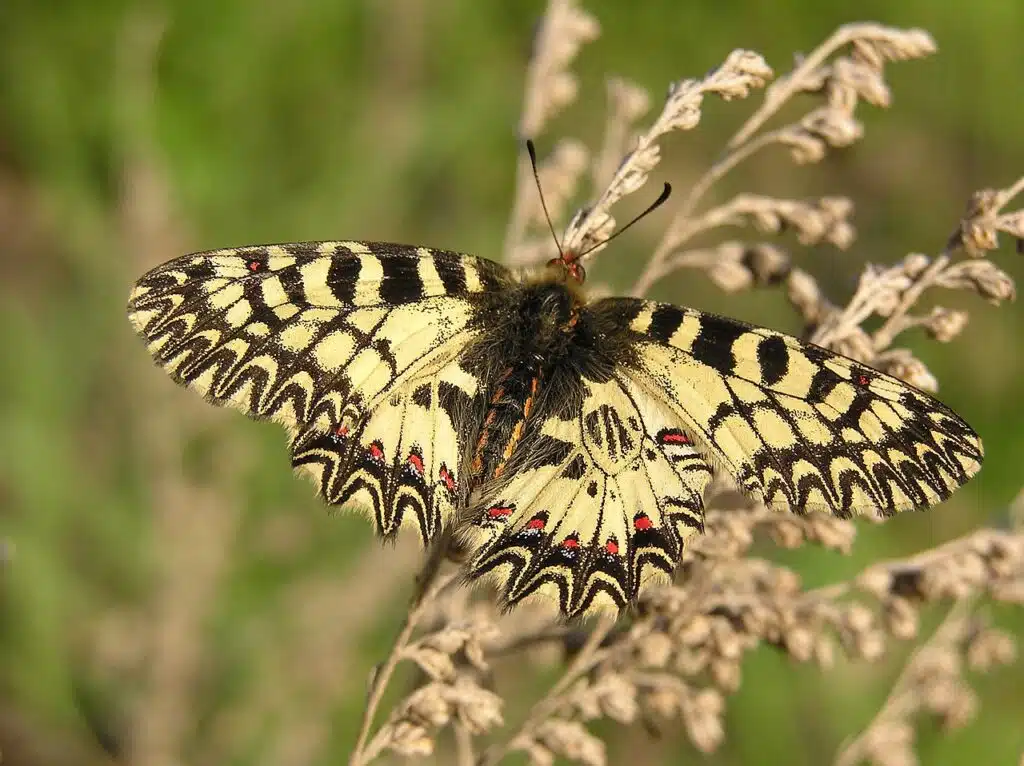
2. Variable Checkerspot
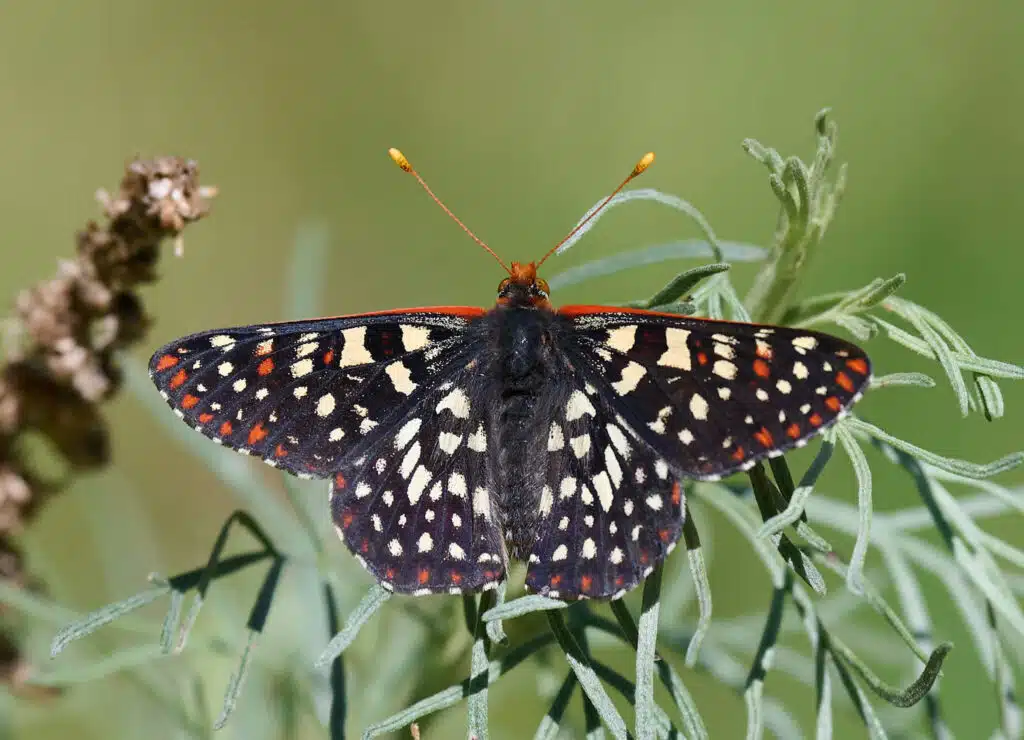
The Variable Checkerspot (Euphydryas chalcedona) is one of the species with a checkered pattern on the wings like many of its species.
Black is the typical base color for this species even yellow or red sections are also seen all across its wings.
This species also has considerable white sections, mainly through multiple white dots.
Black is also the main color of its body while the lower body has yellow or red lines.
This species might also have yellow antennae.
You can see this species across a wide habitat in the US. It lives in Western North America in a region between Alaska and California.
3. Orange Sulphur
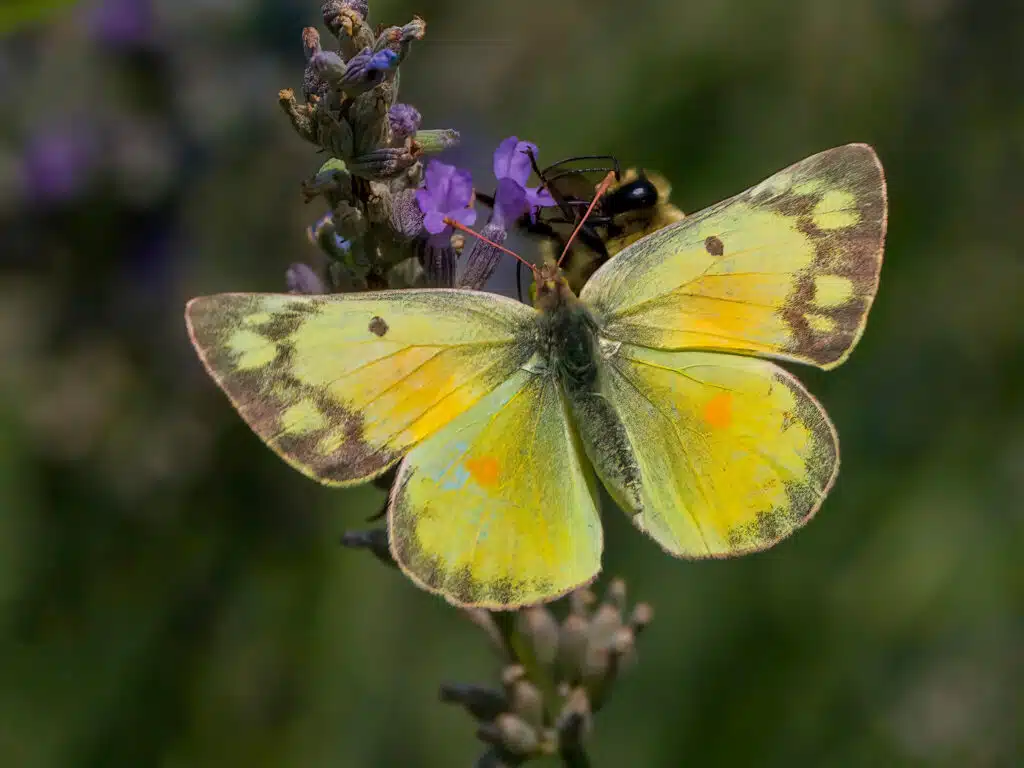
The coloring of the Orange Sulphur (Colias eurytheme) is highly variable.
Butterflies of the Orange Sulphur genus are mostly yellow. Their yellow nuance can vary, but it’s normally closer to orange.
The underside of the species has a bright yellow or a yellow-lime coloring. These butterflies have yellow dorsal wing colors.
Black or dark brown borders are seen on the dorsal wings.
Different color eyespots are further seen in this species.
Some of these eyespots are white with red or yellow borders while others have black borders.
Sizing varies slightly for the species but its wingspan rarely measures more than 1.5 inches.
These butterflies are found all across the US except in high-altitude terrains.
4. Mourning Cloak
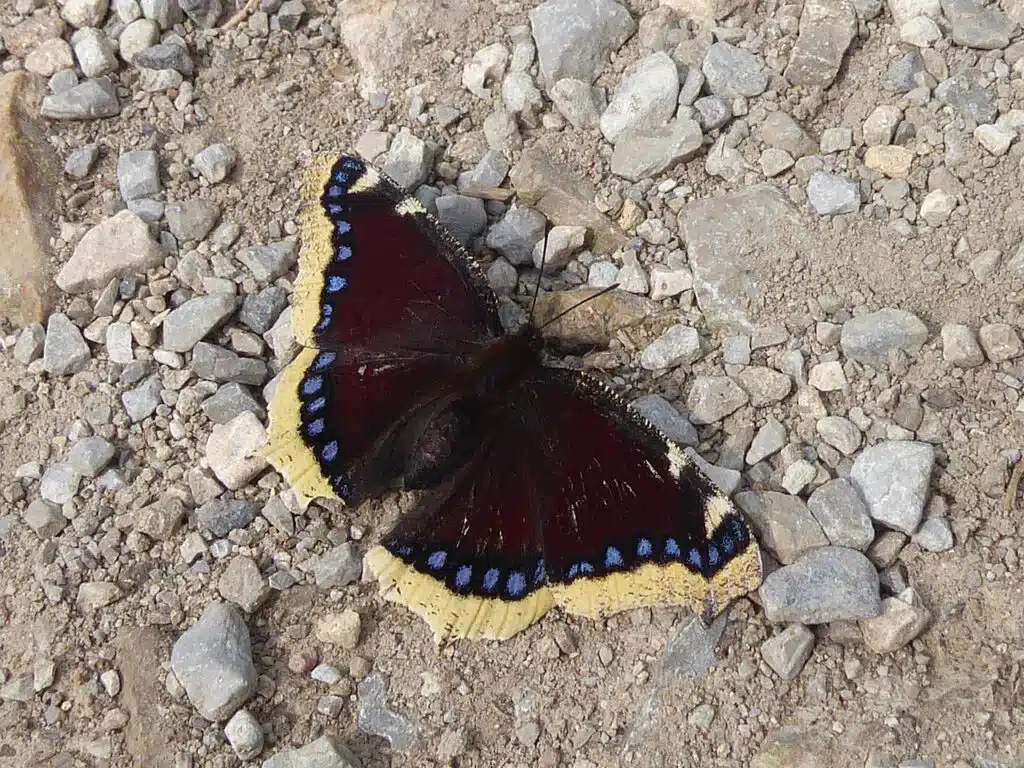
Mourning Cloak butterflies (Nymphalis antiopa) have contrasting black, brown, and yellow coloring.
The black sections of the species are its body and areas around the wings with tiny blue spots.
Yellow dominates the margins of the wings while the central section of the wings is brown-black.
The ventral coloring of the wings looks completely different. Its ventral wings are mostly brown, black, and gray.
Mourning Cloaks are known migrants in North America and Europe.
This species manages to live a long life through its migration towards more hospitable climates in terms of weather.
Mourning Cloak butterflies may live up to a year.
These butterflies are large with an expected adult wingspan of 4 inches.
5. Yucca Giant-Skipper
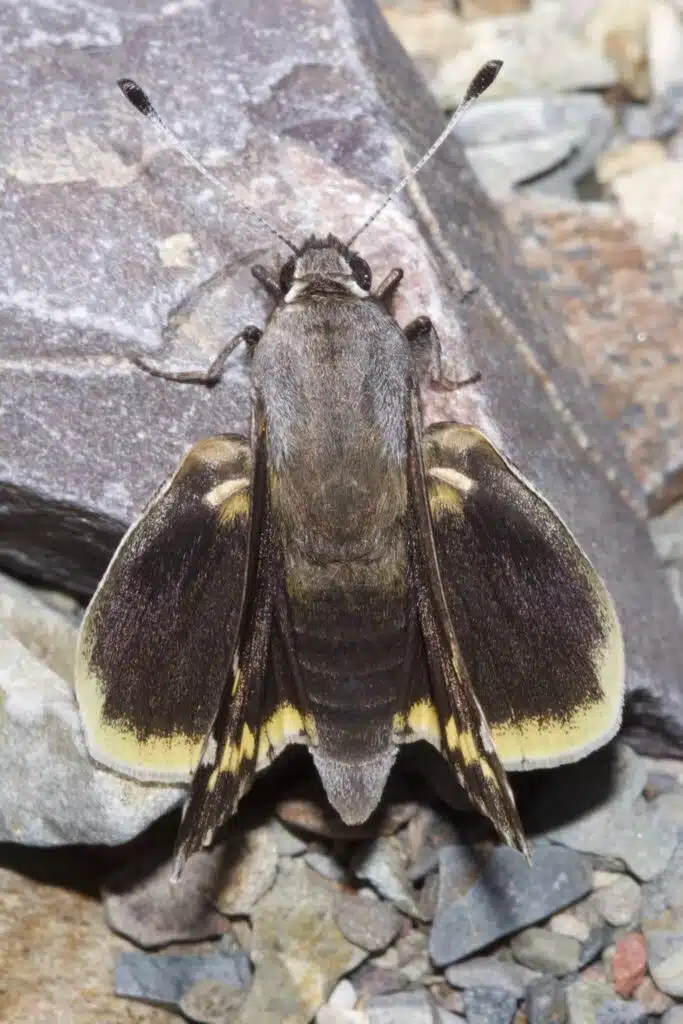
Yucca Giant-Skippers (Megathymus yuccae) come in different colors when comparing sexes.
Both males and females have black and yellow dominant colors but females tend to have more yellow marks across the wings.
This species is known for holding its forewings up in a triangular shape.
Males have black and brown wings with yellow margins that show black veins.
Females have wider yellow margins and a few extra yellow spots.
This species is highly common in many regions around the world with various types of grass being its host plants. Adam’s needle is one of its most common host plants.
6. Pale-banded Crescent
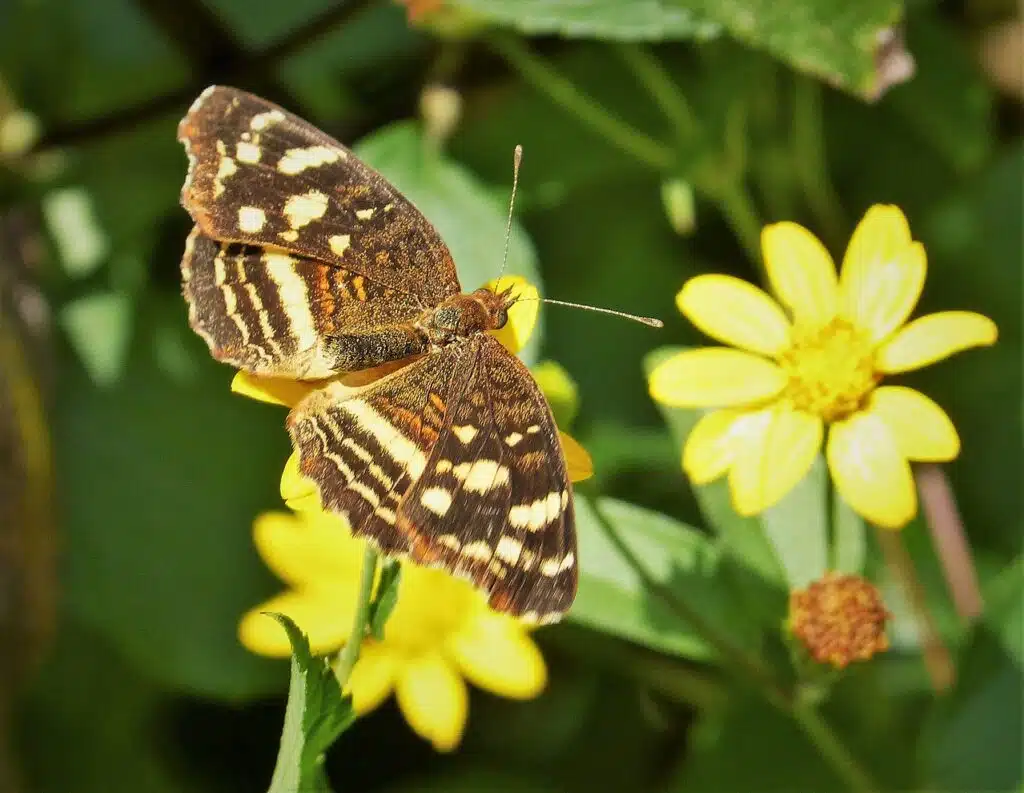
Pale-banded Crescent butterflies (Anthanassa tulcis) are mostly brown, black, and white.
Some members of this species have no yellow coloring at all.
Brown and black are the base color of the dorsal wings.
Pale-banded Crescents get their name from the white bands that cross their wings.
This species lives throughout the year in the extreme South of Texas and Arizona.
The wingspan of the species measures a maximum of 1.1 to 1.4 inches. Pale-banded Crescents are seen around many types of flowers as they consume plant nectar.
7. Yellow Pansy
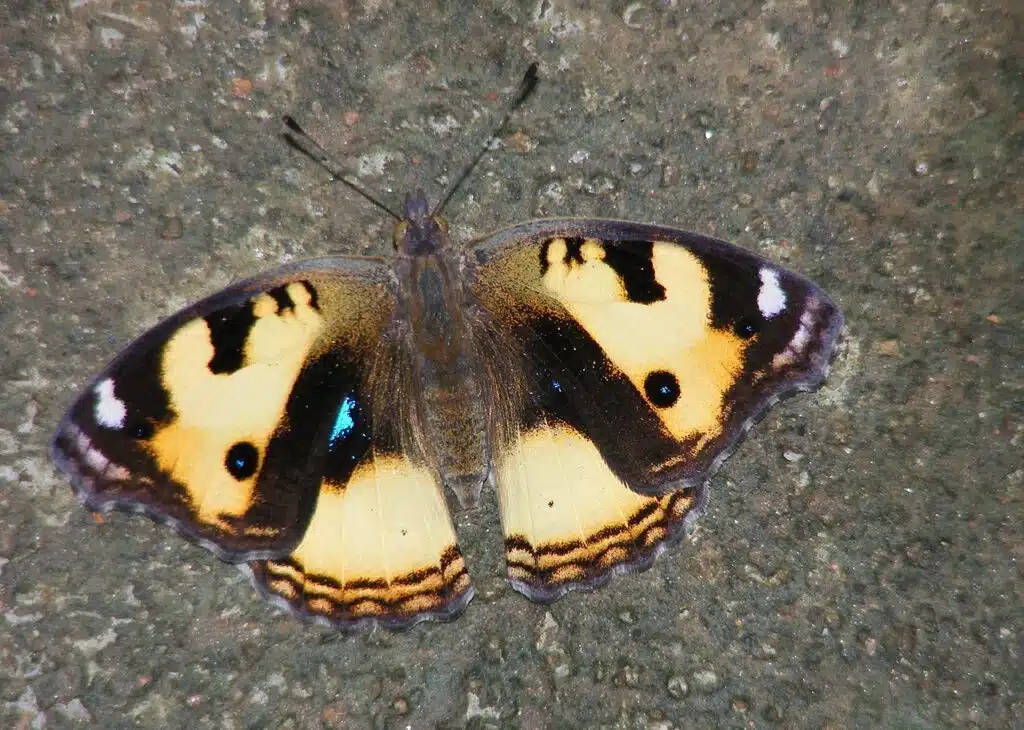
The Yellow Pansy (Junonia hierta) is a large butterfly with a widespread presence in open fields.
Yellow Pansy butterflies are highly common in Asia and Africa.
Contrasting yellow and black colors make the species stand out more than others.
Bright yellow sections and bright orange sections are seen on its black wings.
The upper wings have yellow and orange sections on the black wings while the hindwings have considerably smaller yellow areas.
Males and females of the species have a few small differences in coloring. Males of the species also have small eyespots.
These eyespots are mostly blue with black margins. Females have blue-indigo marks instead.
8. Mexican Dartwhite
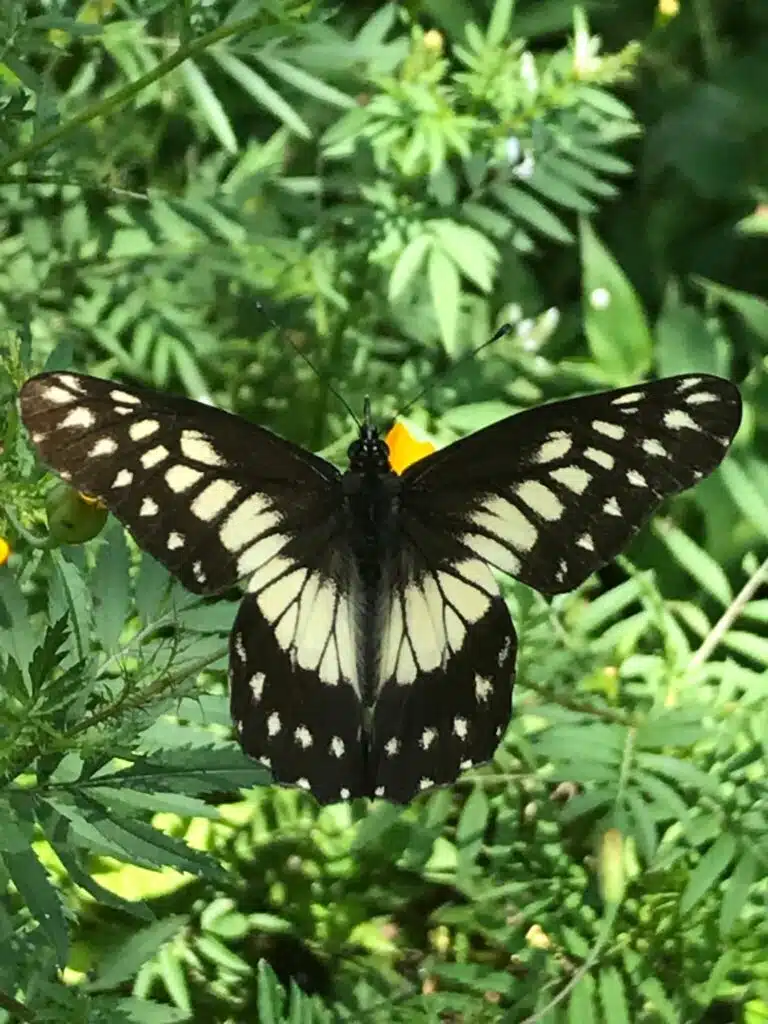
Mexican Darwthites (Catasticta nimbice) are common in the Southern US. These butterflies have black wings with large yellow sections closer to the body.
The outer wings have black coloring with a few smaller yellow spots.
You can find this species in Texas, Arizona, and Mexico.
They have a year-round presence in these warm climates.
Butterflies of this genus feed on plant nectar. Lantana and fuchsia are just a couple of the shrubs they feed on.
The Mexican Dartwhite caterpillar has a parasitic impact where it may even kill the plant it’s growing on.
This caterpillar mainly uses various mistletoes as its host species.
9. Spanish Festoon
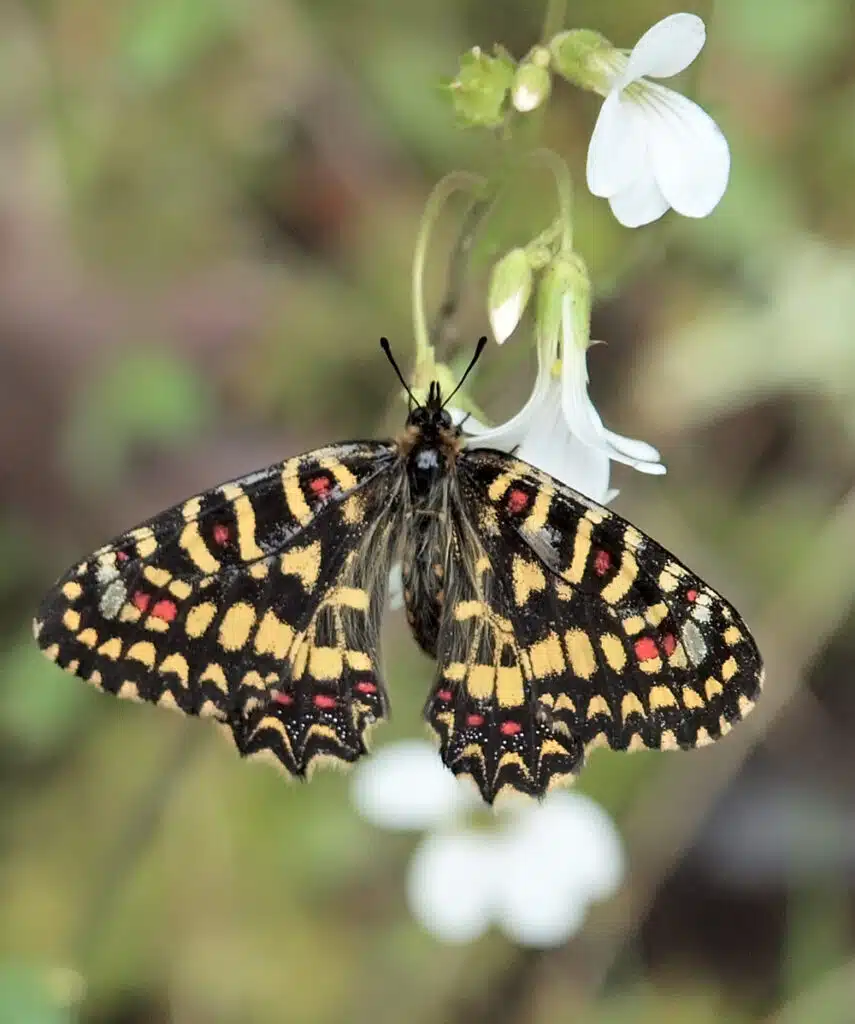
Spanish Festoons (Zerynthia rumina) are types of swallowtail butterflies with colorful wings.
This species is seen both in a black and yellow and black and white morph.
More common in Europe than in other areas, the Spanish festoon has a black body with visible black veins and large orange spots that colors the inner areas of the black veins.
Red spots are also common, especially around the margins of the wings.
Butterflies of this family may also come in black color with white spots instead of yellow spots.
Known for its long wingspan, this species also has a colorful ventral side. White, red, and green patterns are typical on its ventral wings.
10. Yellow Coster
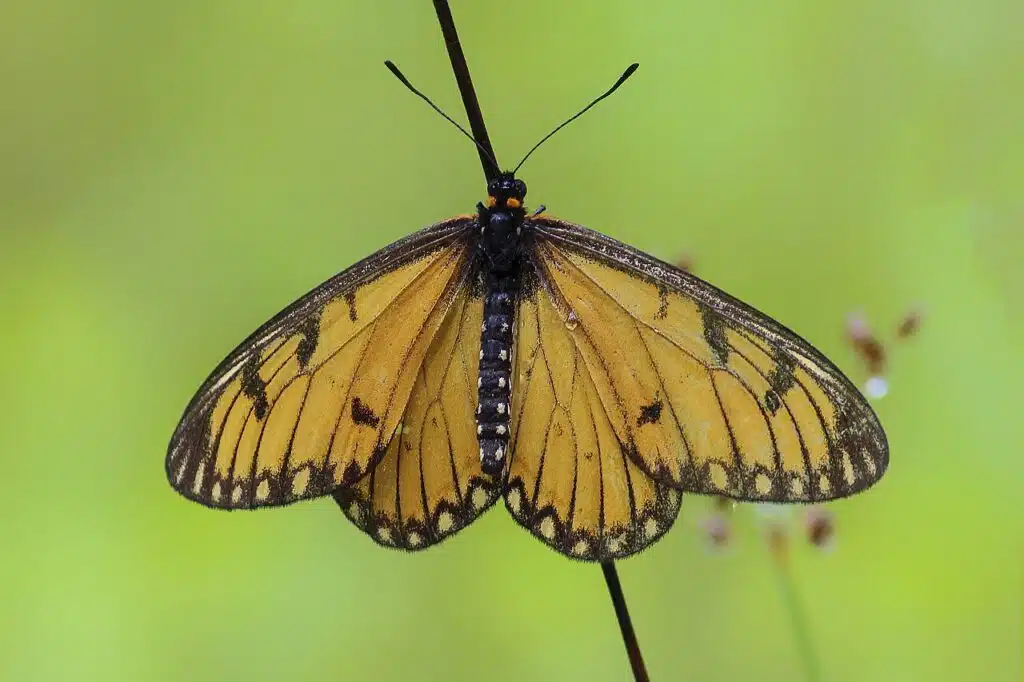
Yellow Costers (Acraea issoria) are among the exclusively-yellow and black species. This color combination is seen both on the wings and the body of the species.
Yellow Coaster butterflies have black wings with black veins and yellow spaces between the veins.
While there are many yellow sections across the wings, these also show tiny black spots that resemble faint black spray paint.
The outer edges of the wings are decorated with zig-zag lines between the veins, which are also black.
Its body is mostly black with yellow dorsal and ventral spots.
The legs and antennae are also black.
Yellow costers maintain their coloring to adulthood. The caterpillars of the species are mostly black with yellow dots which might make them appear poisonous.
11. African Caper
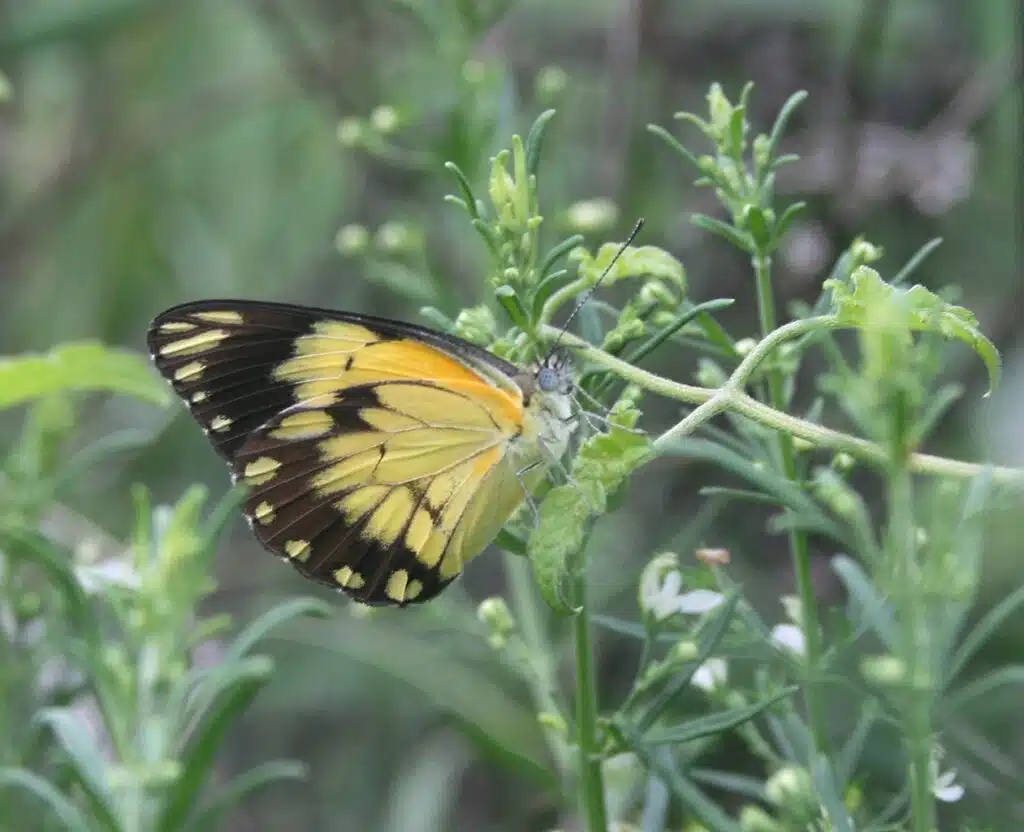
Common South of The Sahara Desert, African Capers (Belenois creona) are some of the most colorful butterflies in the region.
Large coloring differences are seen between males and females. The male is mostly white with black margins that also show white dots.
Females are mostly yellow. Wide black margins are also specific to females together with visible yellow dots.
The female of the species also shows black veins across the wings.
African caper coloring is impacted by seasons. Females tend to have yellow coloring in the wet season with a pale yellow to white color during the dry season.
12. Chocolate Albatross
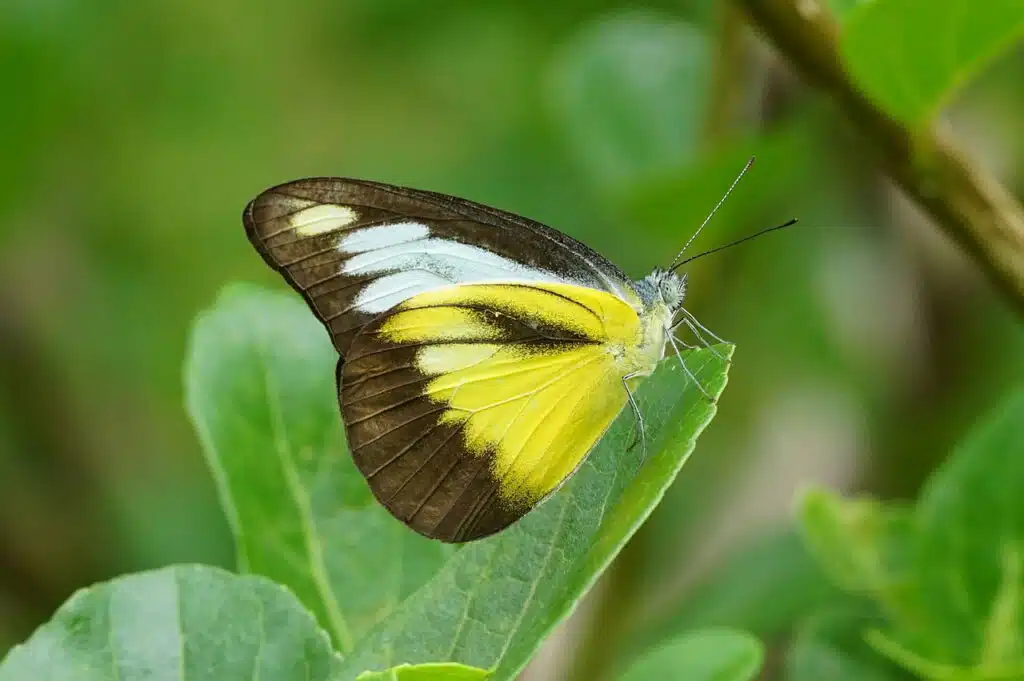
This butterfly species (Appias lyncida) is common in some of the rainiest regions in Asia such as India.
This species has a large wingspan that often measures up to 75mm.
Chocolate Albatross butterflies change or adapt their colors with the rainy season.
Their dorsal coloring is mostly white with black margins. This white color may darken and the margins might change their width with the seasons.
Chocolate Albatross butterflies have black and yellow ventral coloring.
The yellow color is vivid and it may act as a warning sign to predators when the butterfly rests its wings together.
The best place to find this species is in rainy habitats, preferably at high altitudes.
13. Pure-banded Dartwhite
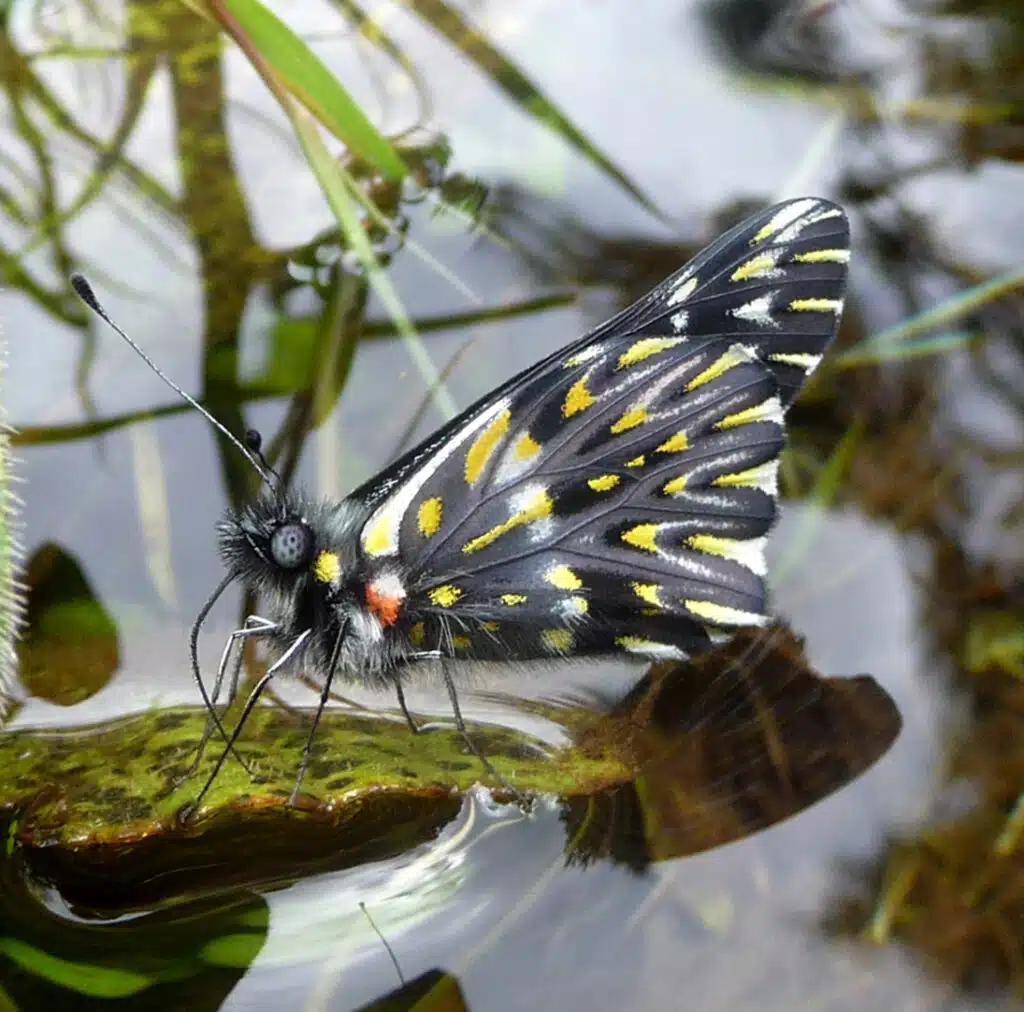
Pure-banded Dartwhite butterflies (Catasticta teutila) are native to Mexico, Nicaragua, and other Central American countries.
These butterflies are almost completely black. They only have a few yellow spots that form bands across their wings.
Females of the species have off-white marks instead of yellow marks across the wings.
Pure-banded Dartwhite butterflies are among the few species that also have black and yellow ventral coloring.
White and red marks are further visible on its ventral wings.
Red or white dots mark the area of the head around the wings ventrally. This is rare in the butterfly world as few species have colorful heads to distract predators to less important areas of the body.
14. Cape Autumn Widow
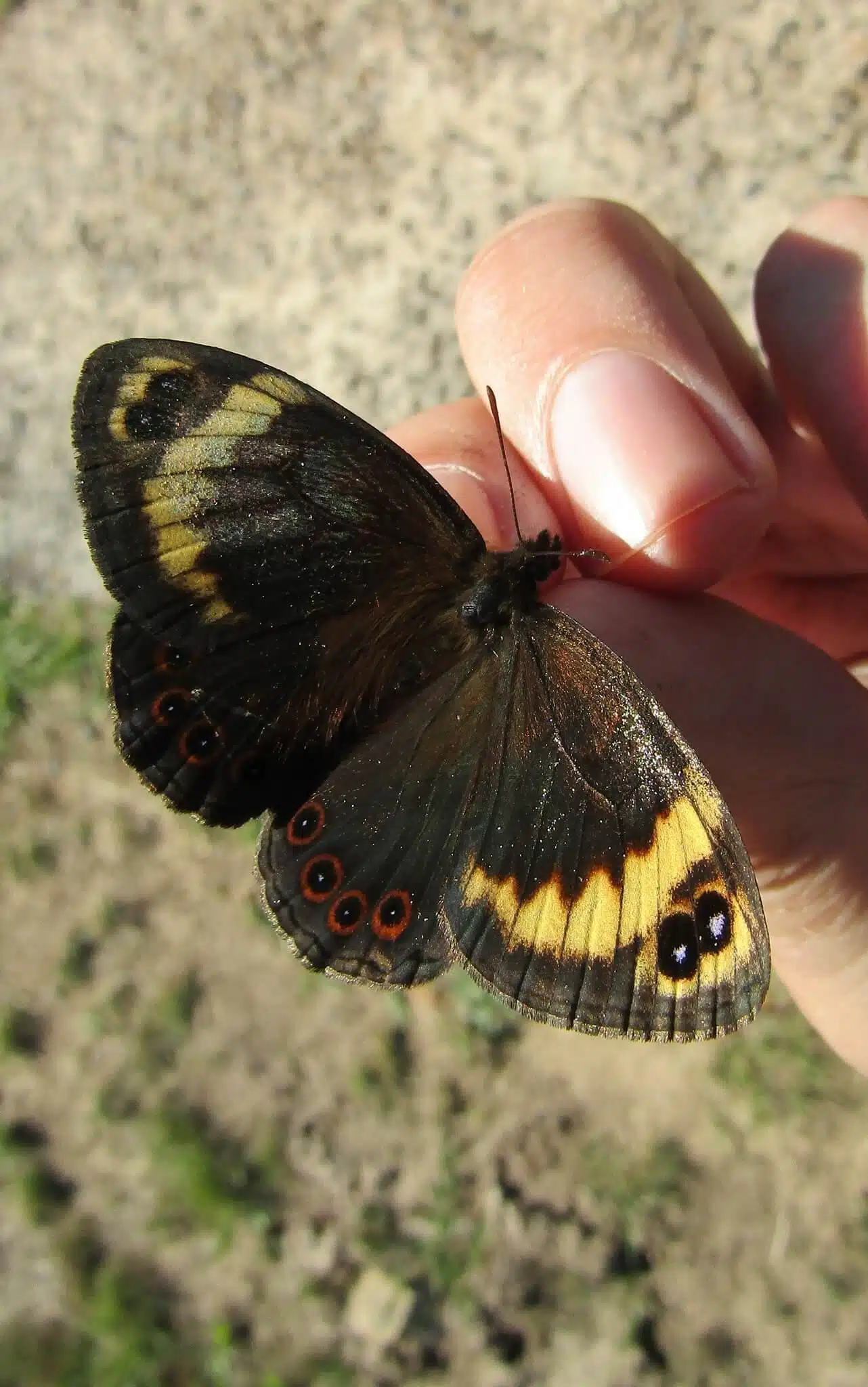
Cape Autumn Widow butterflies (Dira clytus) are only found in South Africa.
The species has a brown color across the wings with black and yellow decorations and black and white eyespots.
The upper areas of its forewings are black with yellow bands to separate them from the red-brown color of the wings.
White spots are seen on the black areas of the wings.
This species also has black and white eyespots across the hindwings which have yellow borders.
Each hindwing has 6 eyespots. These eyespots are all the same in terms of color and size.
15. Little Dancer Metalmark
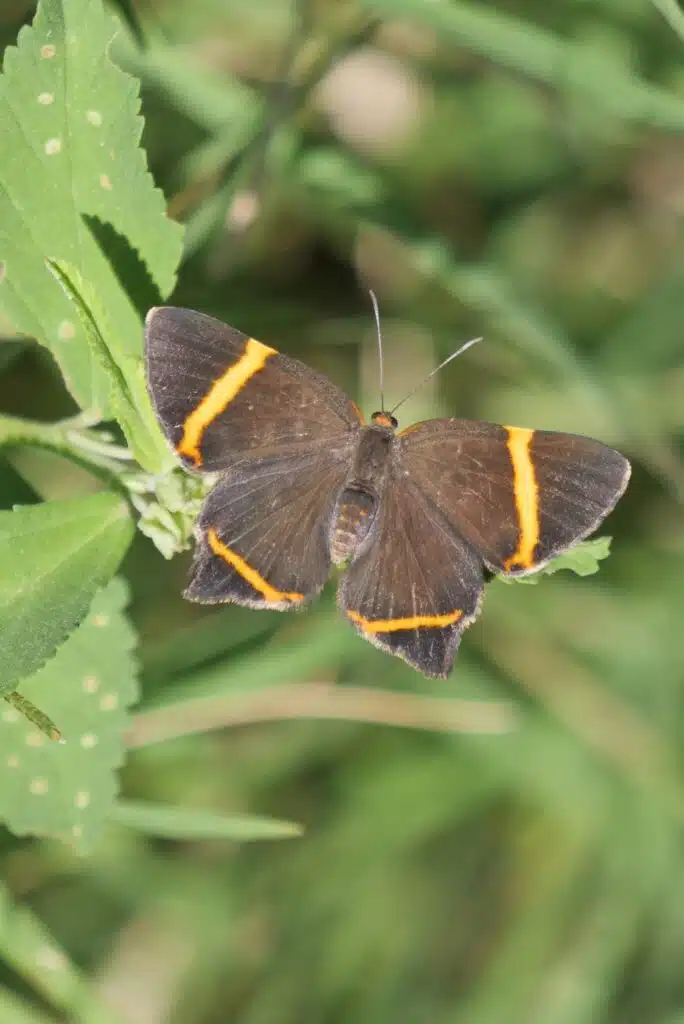
The dancer name of this species (Riodina lysippoides) comes from its up and down flying pattern.
While a metalmark genus butterfly, the Little Dancer Metalmark doesn’t have a metallic color.
It has a matte color.
The species is seen in black and yellow or brown and yellow colors.
Black is dominant across its wings while yellow is only seen in the form of bands.
Yellow vertical bands are specific to their forewings. Yellow horizontal bands are specific to its hindwings.
This species is highly common in South America. These tiny butterflies are most common in Paraguay, Argentina, and Uruguay.
This species feeds on the nectar of herbs and plants, preferably at a higher altitude. White flowers are among its favorites.
16. Northern Chequered Skipper
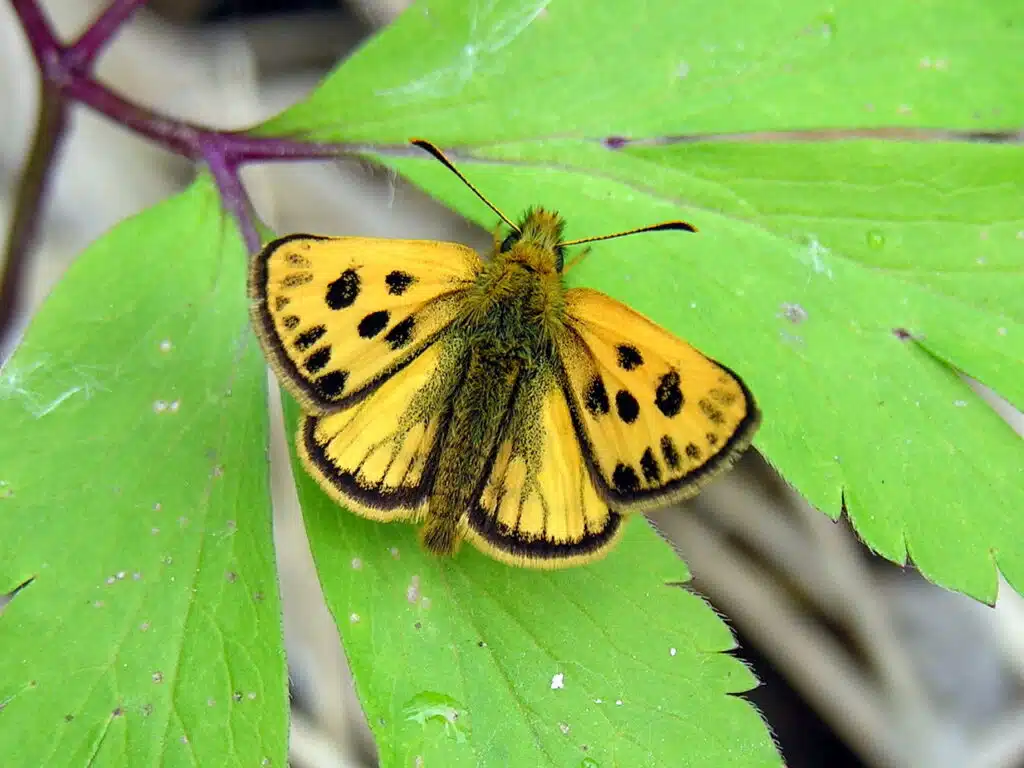
Northern Chequered Skippers (Carterocephalus silvicola) get their name from the Northern European territories they inhabit.
This species of butterflies only has black and yellow colors which vary in percentage according to their gender.
Male Northern Chequered Skippers are mostly yellow while the females are mostly black.
The male butterfly has yellow wings and a mostly yellow body. Black dots decorate its wings.
Females have black wings with yellow spots.
Both males and females have similar colors on the ventral wings. However, yellow is combined with brown to black instead of pure black as on the dorsal wings.
This species has a very short flight period according to the short warm weather season in the region.
The last Northern Chequered Skippers are seen in June across Northern Europe.
17. Soldier Pansy
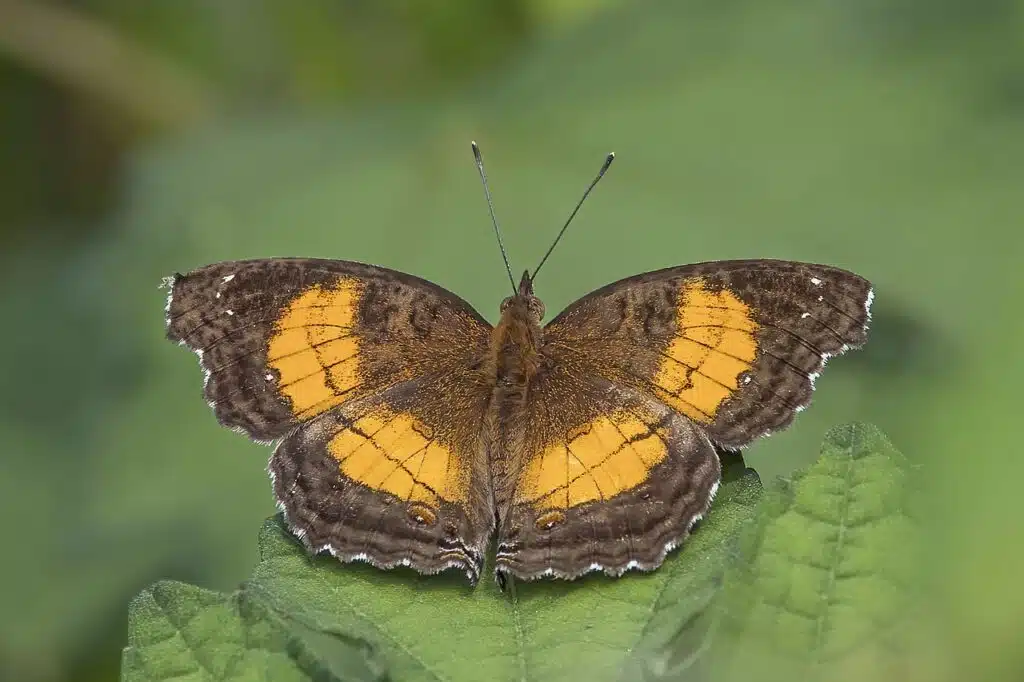
Soldier Pansy butterflies (Junonia terea) are native to regions of Asia and regions of Africa.
This species is seen in different countries from Congo to Ethiopia.
Butterflies of this family have black and yellow colors or black, yellow, and brown coloring.
There’s a mismatch between the sizes of males and females. As in most species, females are larger.
A wingspan of at least 50mm is specific both to males and females.
Soldier Pansy butterflies have a dark brown to black color across the wings. The margins of the wings have a yellow band that runs from the upper wings to the hindwings.
Orange eyespots are seen on the lower hindwings of the males.
The female has mostly yellow and orange coloring. Orange sections are seen on the upper wings.
Black bands are seen across the margins of the females.
Soldier Pansy butterflies also come in a few other morphs. Most other morphs of the species are based on brown and yellow colors.
18. Golden Birdwing
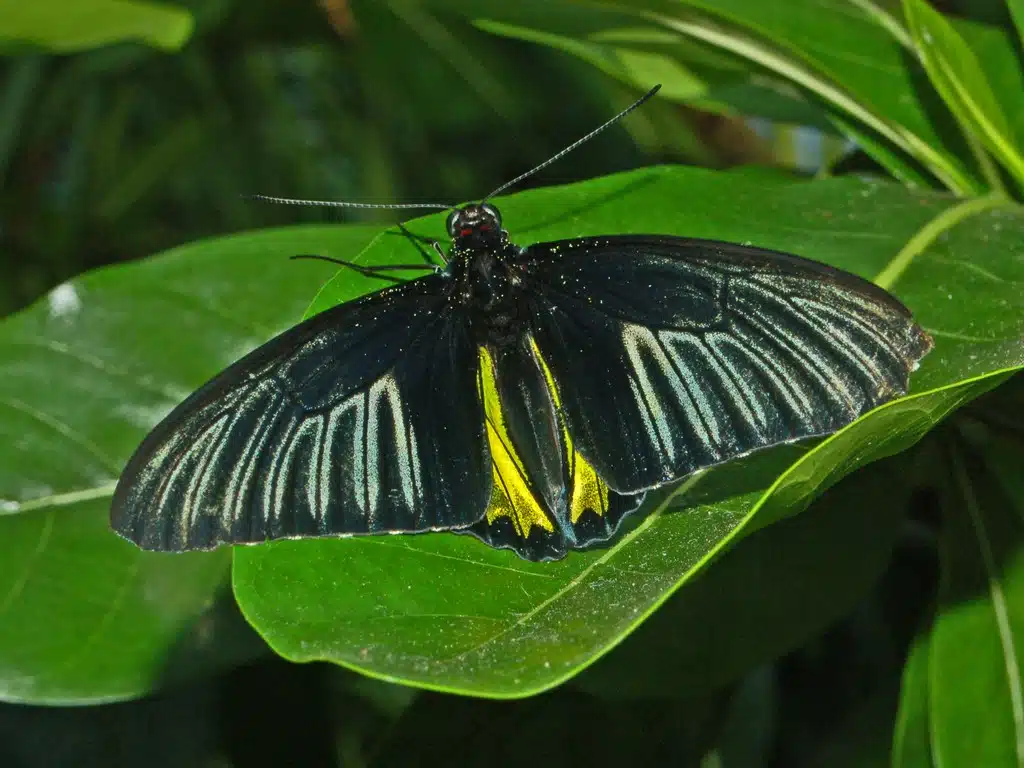
Golden Birdwing (Troides aeacus) is some of the largest black and yellow butterflies in the world.
Females of the species can have a wingspan of up to 6.3 inches.
Part of the Swallowtail genus, these butterflies only live in tropical climates.
Both males and females have mostly black and white colors, with white bands across the upper wings.
The male has black coloring across its upper wings with just a few yellow spots on its hindwings.
Females have a similar color pattern but with larger yellow areas on the hindwings.
The species has a black and yellow body.
When it flies, this butterfly mostly appears black as the ventral side is black-dominant.
Some morphs of this butterfly species also show 2 red spots behind the head, but these are too small to be noticed from a distance.
19. Southern Birdwing
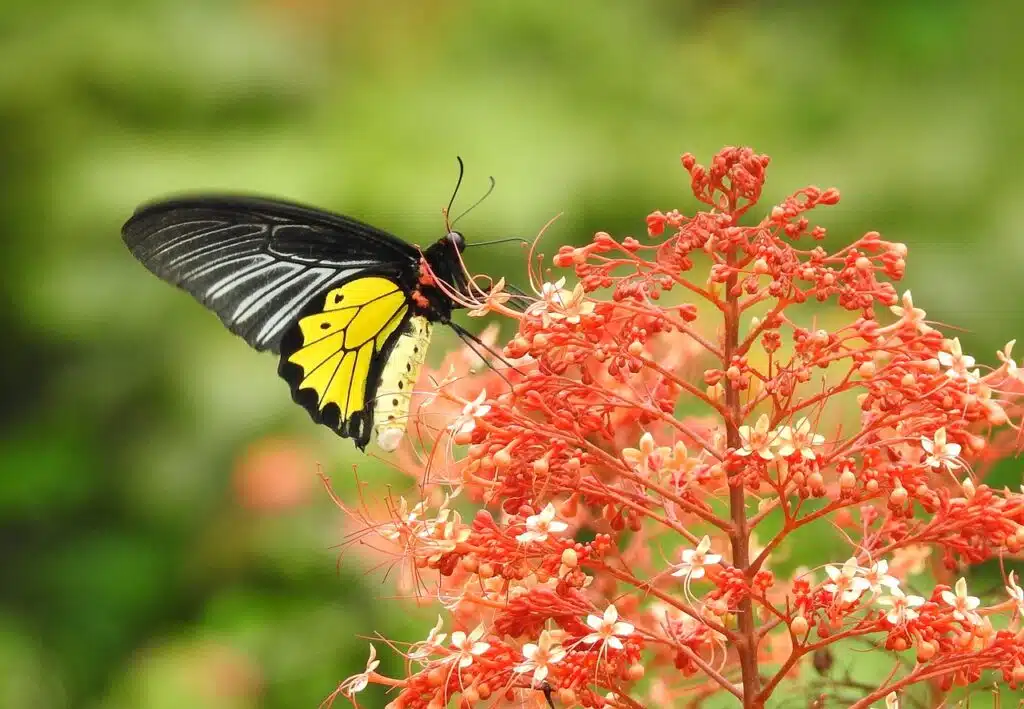
Similar to the Golden Birdwing, the Southern Birdwing (Troides minos) is also a black and yellow butterfly with a large wingspan.
It can reach a wingspan of up to 170mm.
This species is native to India where it lives at high elevations.
You can see these butterflies during the monsoon season or soon after the monsoon season.
The base color of the species is black. Its upper wings have white borders around the veins while its lower wings are yellow and black.
A similar yellow and black color combination is further seen on the ventral side of this species.
The body of the butterfly is also yellow and black without resembling its host plants. Lantanas are among the favorite food sources for the Southern Birdwing.
20. Chocolate Grass Yellow
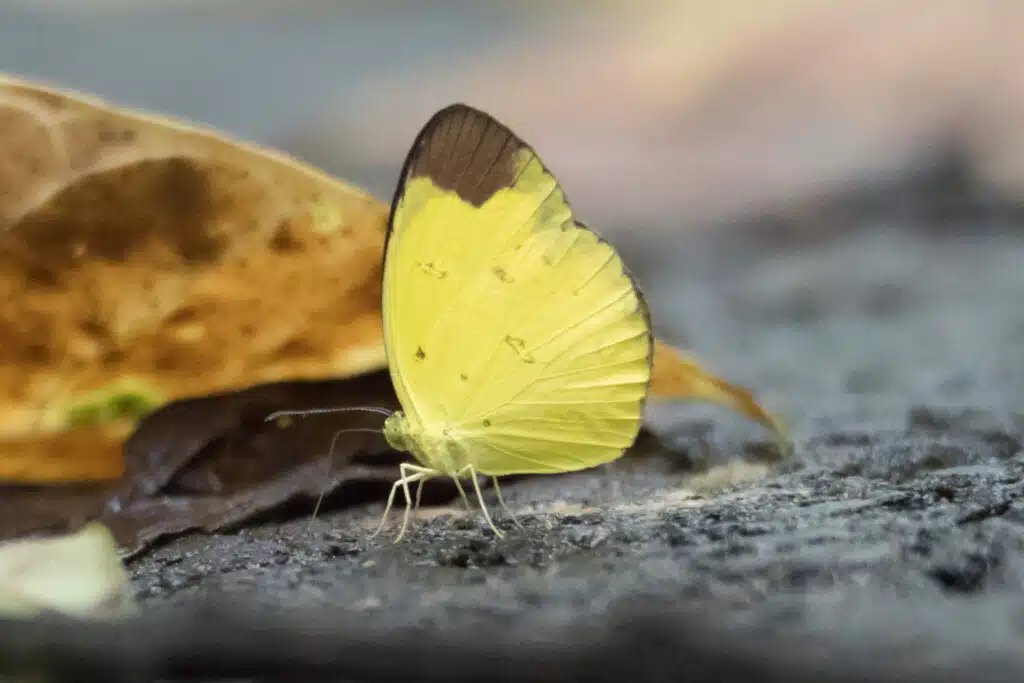
Also native to Asia, the Chocolate Grass Yellow (Eurema sari) is among the common yellow and black species.
This butterfly has yellow wing colors with wide black borders on the upper wings and narrow black borders on the hindwings.
Fine black veins are also distinguishable in the species.
The body of the butterfly is partly yellow and partly black.
Ventral coloring is mostly yellow. Tiny yellow and black eyespots are further distinguished on the ventral side of the wings.
This species is mostly seen around its favorite bean family plants which it uses for nectar.
21. Hydaspes Eighty-Eight
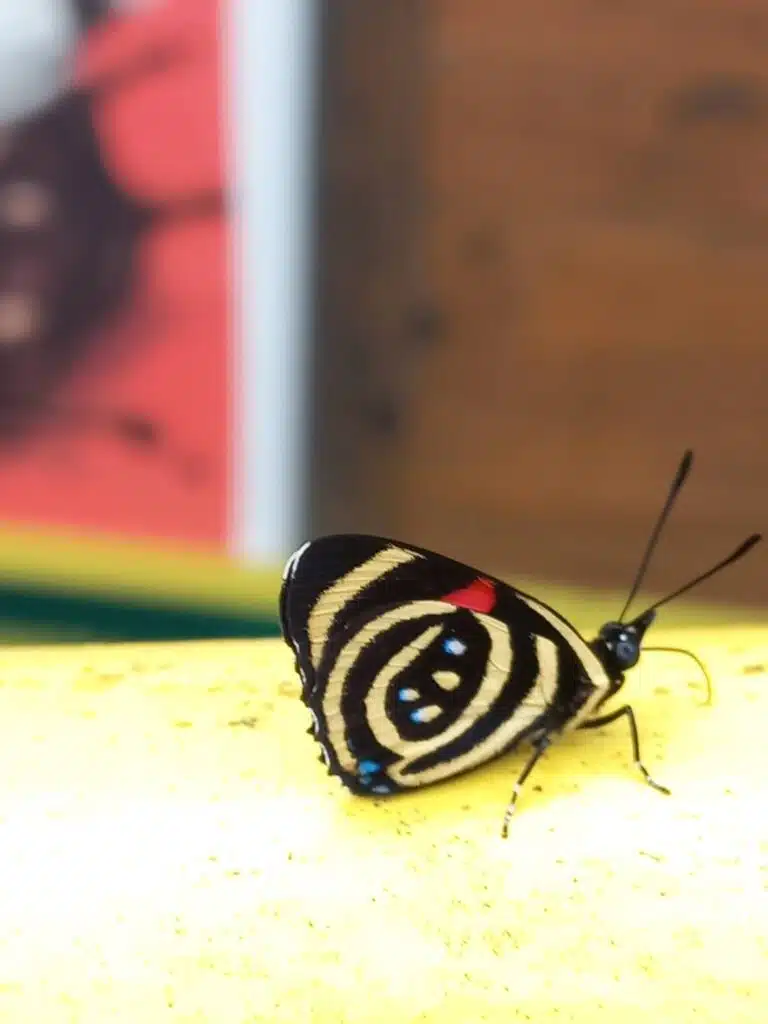
This colorful butterfly (Callicore hydaspes) is native to South America.
It’s mostly found in Brazil and across Argentina. It’s only its ventral wings that are black and yellow as its dorsal wings are black, blue, and red.
Its ventral wings completely mimic a large eyespot on each wing.
The ventral wings are black with yellow circles and 4 yellow and white dots in the center.
This large eyespot mimicry of the dorsal wings is purely defensive as this butterfly tries to resemble large species and scare away predators.
The species has a small to medium size. It normally grows to a wingspan of at least 35mm.
22. Melantho Tigerwing
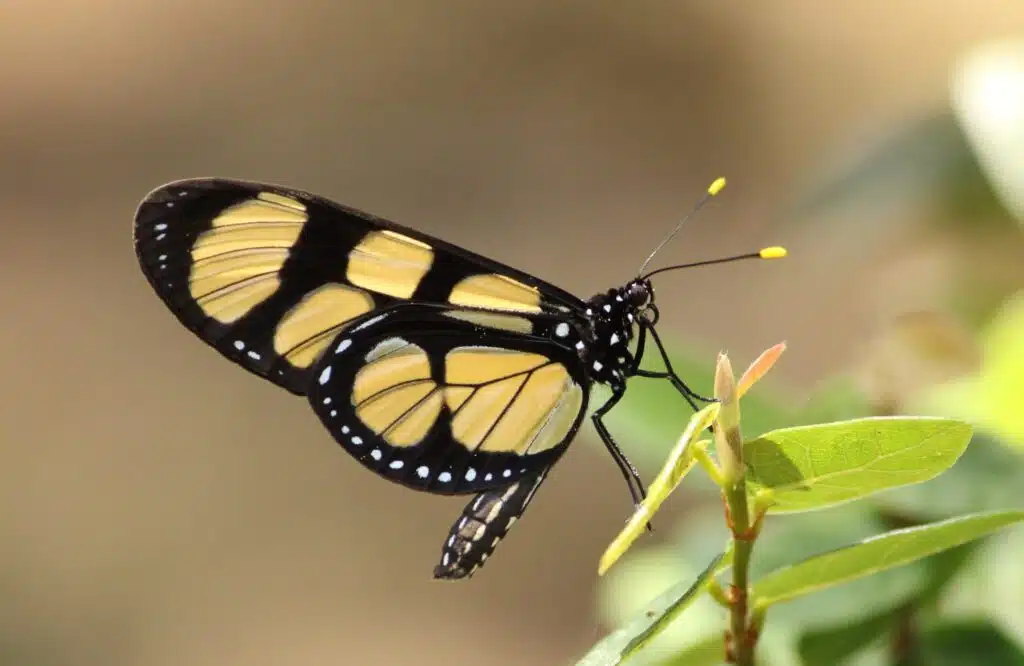
Found around tropical regions, the Melantho Tigerwing (Thyridia psidii) gets its name from its yellow-orange and black-colored wings which resemble the coloring of certain tigers.
This species has a mostly yellow or mostly orange coloring across the wings. Black comes as decoration across the wings as well as along the margins of the wings.
White dots are further distinguished on the black margins of this species.
The body of the Melantho Tigerwing is dominated by black coloring. Tiny white dots are further distinguishable across the body.
These white dots might make some of its predators take it as a poisonous species.
23. Google-eyed Eighty-Eight
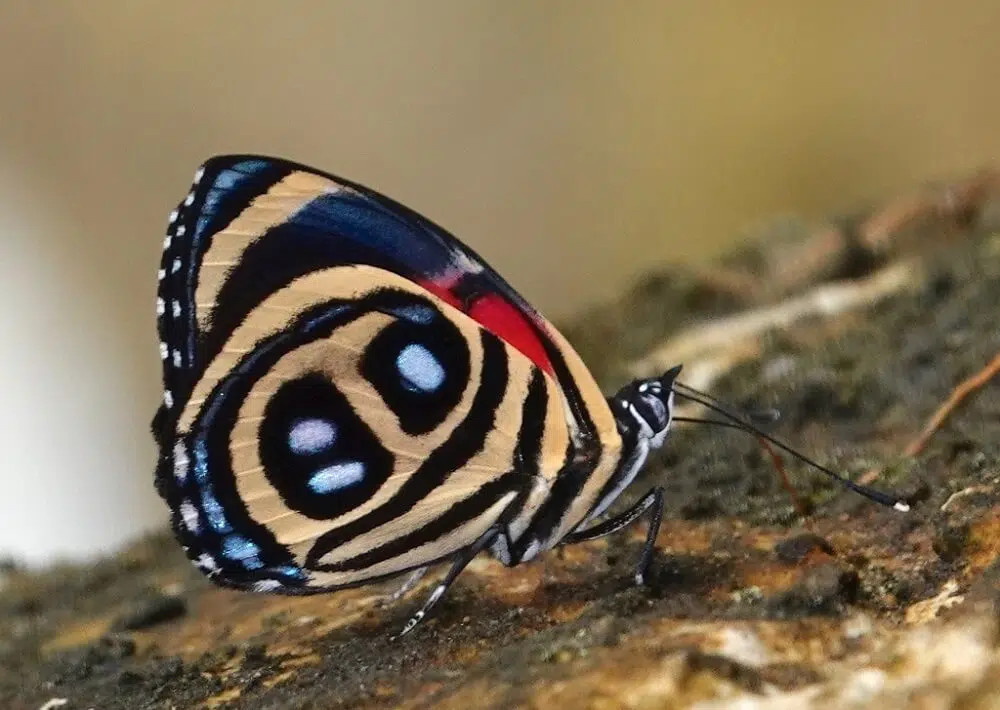
Similar to the Hydaspes Eighty-Eight, the Google-eyed Eighty-Eight (Catagramma pyracmon) is among the butterfly species with black and yellow ventral wings and colorful dorsal wings.
The dorsal color of the wings is pink-red. Black and blue borders are specific to this side of the wings.
The ventral wings of the species are mostly yellow. Black circles that form a very large eyespot are seen across each wing.
There are 2 to 3 central eyespots on these ventral wings. They can be yellow and black or blue and black.
Google-eyed Eighty-Eight butterflies try to mimic the eyes of predatory species to keep their predators away.
24. Eversmann’s Parnassian
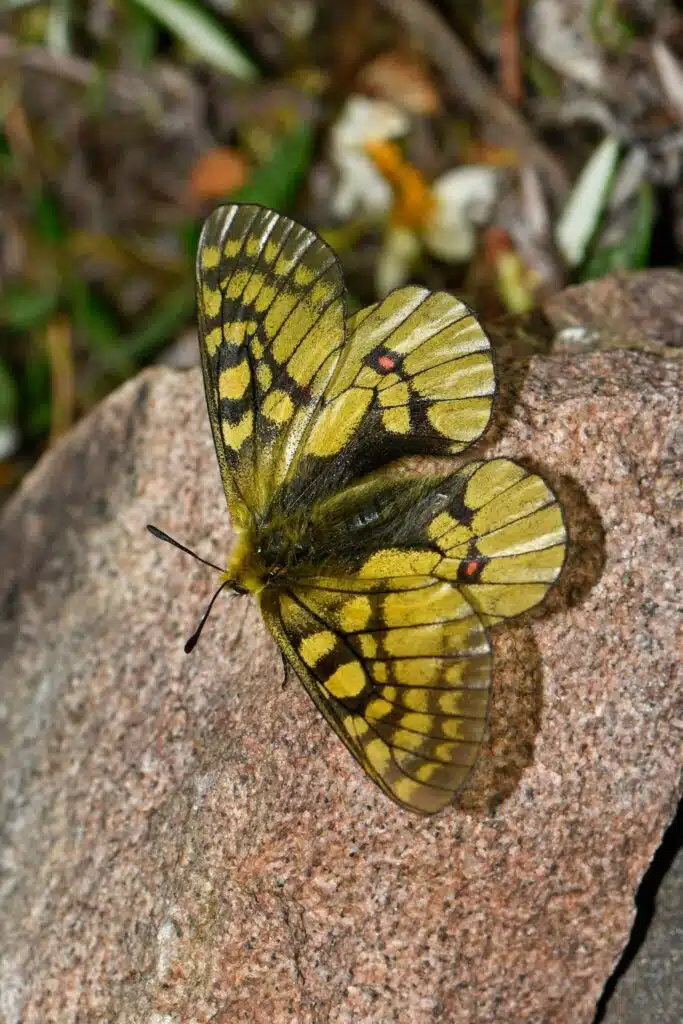
This species of Parnassian (Parnassius eversmanni) is native to Alaska, Russia, and Japan.
Butterflies of this genus have a mostly yellow base color which varies in intensity from males to females.
The male Eversmann’s Parnassian has a dark yellow color while the female has a pale yellow-white color.
Both males and females exhibit black veins and a mostly black body with just a few yellow sections.
Further color differences can be seen on the upper wings of the female. This section of the wings is mostly white and almost looks transparent.
25. Banded Tigerwing
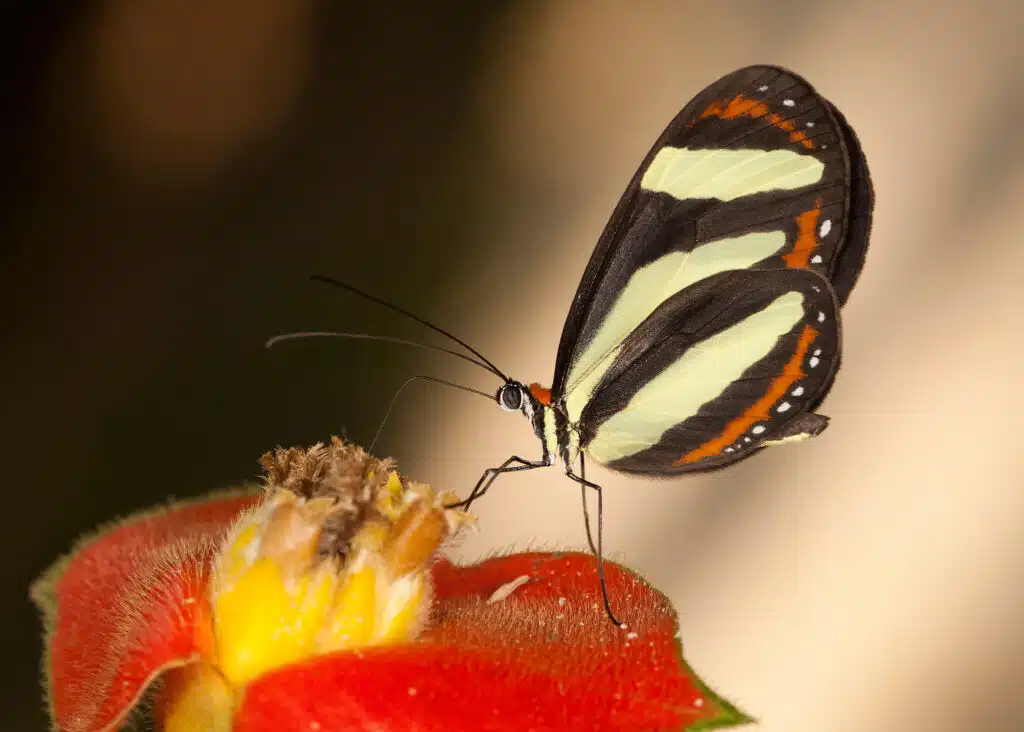
Banded Tigerwings (Aeria eurimedia) are native to Central and South America. These are mostly black and yellow butterflies with small coloring differences between the sexes.
Males have yellow wings with black margins and a black body.
Females have yellow and black coloring as well. The only differences in coloring are the tiny white dots visible across the black margins on the wings of the female.
26. Clio Crescent
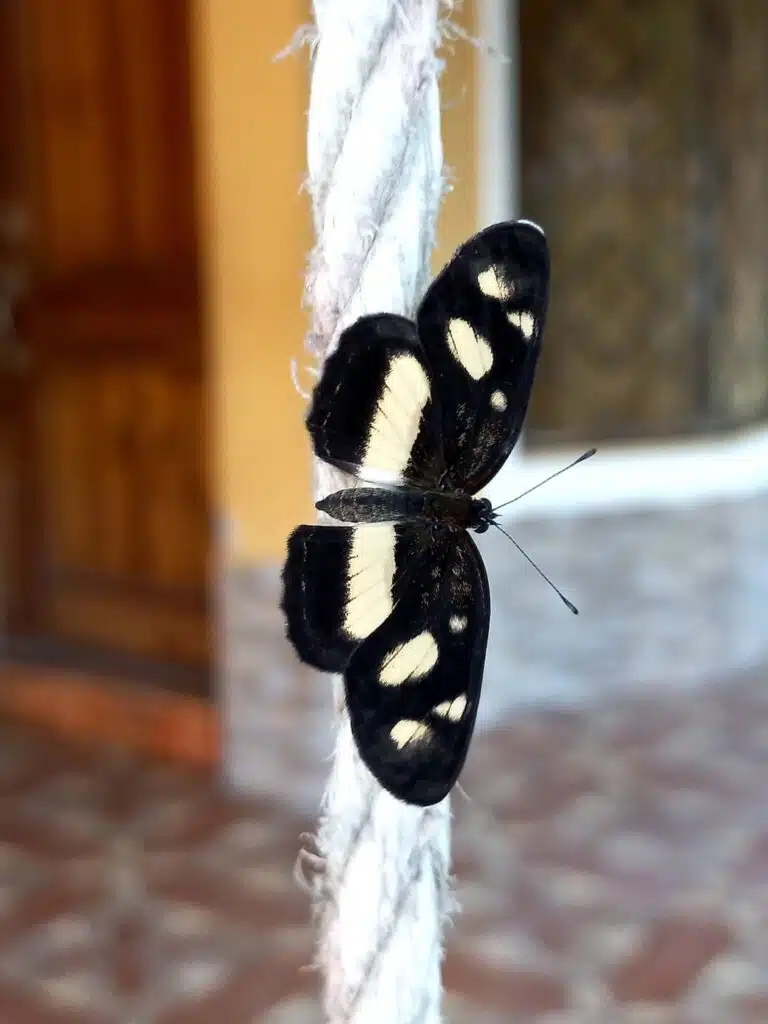
Clio Crescent butterflies (Eresia clio) are South American natives.
They have black, yellow, and orange wing coloring. The wings are mostly black with black bands.
The spaces between the black bands are either orange or yellow.
White marks are also characteristic of the wing margins.
Clio Crescent can best be seen when puddling. This is the habit of the male Clio Crescent butterflies to drink mineral-rich juices directly from mud.